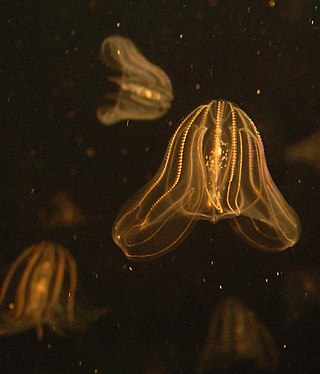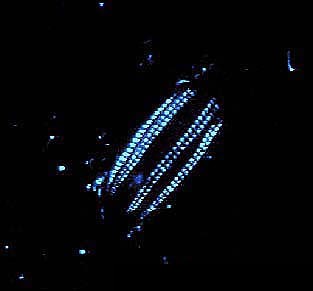
Lobata is an order of transparent marine invertebrates belonging to the phylum of Ctenophora in the class Tentaculata, and are commonly referred to as comb jellies or sea gooseberries. There are currently 19 extant known species in the order of Lobata. Members of Lobata exhibit a compressed body in the vertical plane and a pair of oral lobes. They are known to inhabit marine pelagic surfaces and the marine shores.

Bathocyroe fosteri is a species of lobate ctenophore found at intermediate depths in all the world's oceans. The species is very common and abundant near the Mid-Atlantic Ridge. It is bioluminescent, and is typically observed hanging motionlessly in an upright or inverted posture although it can flap its oral lobes to swim. This deep-sea comb jelly is named for Alvin (DSV-2) pilot Dudley Foster, who collected the first specimens.

Heteroconchia is a taxonomic infraclass of diverse bivalve molluscs, belonging to the subclass Autobranchia.

Chrysaora colorata (Russell), commonly known as the purple-striped jelly or purple-striped sea nettle, is a species of jellyfish that exists primarily off the coast of California from Bodega Bay to San Diego. The bell (body) of the jellyfish is up to 70 cm (2.3 ft) in diameter, typically with a radial pattern of stripes. The tentacles vary with the age of the individual, consisting typically of eight marginal long dark arms, and four central frilly oral arms. It is closely studied by scientists due to not much being known about their eating habits. A 15-foot-long specimen has been seen.

Ocyropsis is a genus of Ctenophores, which are commonly known as Comb Jellies. Ocyropsis belong to the family of Ocyropsidae. Ocyropsis possesses two large lateral muscular lobes and four auricles, and appear pale and translucent in color. Ocyropsis habitat is not precise as their gelatinous composition can make it difficult to study. They have been found in warm and cold waters. Unlike other, slow swimming Ctenophores, Ocyropsis are efficient in evading their predators. They use their oral lobes for additional propulsion and a secrete luminous mucous in efforts to evade predators. The muscular oral lobes of the Ocyropsis are used to grab its prey, and then moved to the prehensile mouth for absorption.
The World Register of Marine Species (WoRMS) is a taxonomic database that aims to provide an authoritative and comprehensive list of names of marine organisms.

Bolinopsidae is a family of ctenophores.
Eurhamphaeidae is a family of ctenophores.

Haliclystidae is a family of stalked jellyfish in the order Stauromedusae.

The Venus girdle is a comb jelly in the family Cestidae. It is the only member of its genus, Cestum, and is also the largest of all known ctenophores.

Beroe, commonly known as the cigar comb jellies, is a genus of comb jellies in the family Beroidae. Beroe exhibits bioluminescence.

Bolinopsis infundibulum, commonly known as the common northern comb jelly, is a species of comb jelly in the family Bolinopsidae. It is found in the northern Atlantic Ocean and was first described by the Danish naturalist Otto Friedrich Müller in 1776.

Pleurobrachia pileus is a species of comb jelly, commonly known as a sea gooseberry. It is found in open water in the northern Atlantic Ocean, the North Sea, the Baltic Sea and the Black Sea, and was first described by the Danish zoologist Otto Friedrich Müller in 1776.

Thalassocalyce is a genus of ctenophore, or comb jellies, known from the California Coast, Gulf of Mexico, and west north Atlantic. It is represented by a single species, Thalassocalyce inconstans, which is the only species in the family Thalassocalycidae and the order Thalassocalycida. T. inconstans is a pelagic ctenophore typically occurring in upper-mesopelagic depths, but has been observed at depths up to 3,500 m in Monterey Canyon.

Borsonia ochracea is a species of sea snail, a marine gastropod mollusk in the family Borsoniidae.

Euplokamis is a genus of ctenophores, or comb jellies, belonging to the monotypic family Euplokamididae. It shares the common name sea gooseberry with species of the genus Pleurobrachia. Despite living for hundreds of millions of years in marine environments, there is minimal research regarding Euplokamis, because they are uncommon. Research on the evolution of the basic body structures of diploblastic metazoans revealed that there are four major phyla, including the Ctenophores. Although the morphology of Euplokamis often resembles the medusa stage of Cnidarians, their eight rows of combs are one distinguishing feature that led to the official classification of Ctenophores. After being originally described by Chun (1879), the family Euplokamididae was expanded by Mills (1987) due to the discovery of a new species, Euplokamis dunlapae. Further research indicated that Euplokamis should be identified from Mertensiidae due to the rows of combs and some compression. They may also be distinguished from the genus Pleurobrachia due to their more elongated shape. Additionally, various adaptations of Euplokamis have been observed such as the use of tentacles for movement/feeding, a complex nervous system, and bioluminescent capabilities. Other characteristics including a defined mesoderm, lack of stinging cells, developmental differences, and symmetry supported the reclassification of these organisms.
Platyctenidae is a family of ctenophores belonging to the order Platyctenida.

Bolinopsis mikado is a species of ctenophore in the family Bolinopsidae. It is found in the waters of Japan.
Euplokamis helicoides is a species of marine ctenophore. It has been reported to be a fast swimmer.
Euplokamis evansae is a marine species of ctenophore.















